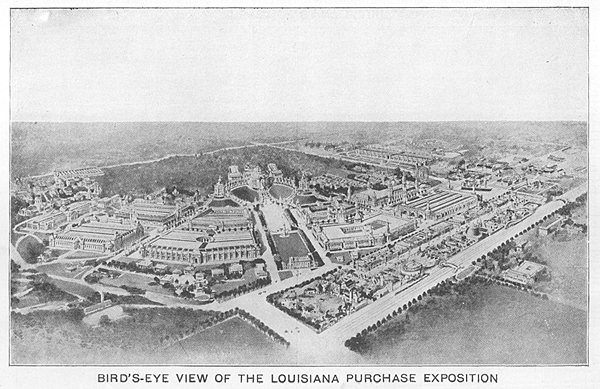
from
Chapter XXI: Side Lights of the Pike, Pages 275-276,
Pictorial History of the Louisiana Purchase and the
World's Fair at St. Louis, 1904.

Dame Nature might learn some valued lessons were she to visit the Pike and study some of the ingenious devices that have been evolved to assist her in her multifarious duties. Scientists insist that in the baby incubator displayed at the Louisiana Purchase Exposition a device has been perfected whereby many little lives that would otherwise be lost may now be saved.
Nature nowadays seems scarcely naught but the auxiliary of science, for artificial methods are being so wonderfully perfected that perhaps in another century we will be able to dispense with her altogether. The physical culturists declare that normal methods of respiration are faulty in the extreme, so perhaps it will be the same with baby culture, and incubation will be found superior to a mother's care.
The incubator, it is claimed, has saved the lives of thousands of little ones who would surely have died under the well-meaning but inefficient care of inexperienced mothers. An equable temperature, pasteurized milk, filtered air and the untiring services of a trained nurse, are things unattainable except to the wealthy.
The records of the large hospitals show that as a life-saving device the incubator is invaluable, and the World's Fair exhibit teaches a wonderful lesson in scientific advancement. Light and warmth are primordial factors in promoting growth, and the high-ceiled apartment where the little embryos are housed is flooded with light and kept at a temperature of 90 degrees.
The incubator is a square box of shining metal, resting on iron supports and raised about three feet from the floor. It is air-tight, except for the ventilating pipe which connects with the box at the left, ending into it a continual stream of pure air from the outside. It is filtered by passing through a tube capped with a thin layer of absorbent cotton, which frees it from dust and microbes. An even temperature is maintained by the air passing over hot water pipes, while an exhaust pipe carries off all impurities.
A metal wheel is constantly kept in motion by the escaped air, and is an indicator of the rapidity with which the oxygen is consumed. In every compartment there is a thermometer for the guidance of the nurse. The partition is provided with two glass sides, so that the physician and attendant may observe the patient without admitting unfiltered air or disturbing the temperature.
On the front of the box is a chart, on which is registered the weight, size, temperature, pulse, respiration and general physical condition of the occupant.
Every two hours the babies are taken from their cozy nest, wrapped in a heated blanket, and fed by the nurse in view of the public. If the baby is too weak to take nourishment from a spoon a silver tube is passed into the stomach.
Unless too weak, it is unswathed from its bandages and dusted with rice powder every day.
It must have been in the incubator forty days before it can take milk from a bottle. By this time it begins to show a faint semblance to human beings, and to be alive to the approach of meal time. From the skinny, uncanny bit of human skin and bones it has developed into a rosy baby, with, most likely, a long lease of life.